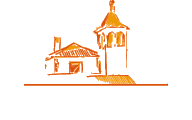
One of the biggest region specialities is its bilingual:
people speak Castilian (i.e. main Spanish language) and Valencian.
Both languages are officially recognised. That is why many
geographical places names may be spelled in two ways:
Xàtiva/Játiva,
Alacant/Alicante,
Xúquer/Júcar,
or Mare
de Deu/Nuestra Señora
for Holy Mary.
Geographical location
La Torreta is located just outside the Corbera village,
on a hill side, in the Ribera Baixa.
It is half an hour South of Valencia, and a quarter of an hour
away from fine sandy beaches.
The scenary is spectacular (50 m above the plain).
First, you see the orange trees, the village and the medieval castle of Corbera.
Then, more orange trees, rice fields and finally the Mediterranean Sea.
Looking South-East, you get the mountain covered with pine trees.
Behind the house, pine trees, olive trees, and local trees called
garrofers (carob trees).




Weather
The climate is delightfull all year round. Winters are mild, and summers are not too hot.
This is due to la Torreta's great location, close to both the sea and the mountain.
It's relaxing to rest for hours on the terrace, with the fresh air gently caressing your face !
What a privilege to enjoy a generous sun in the middle of the winter ! The Nothern cold and humid
winter is quickly forgotten here ...
Average temperature at La Torreta: 23°C in summer, 14°C in winter.
Number of hours of sunshine per year: 2,760.
Beaches
Here is the kingdom of great fine sandy beaches, stretching to the horizon.
Water is quiet, warm and cristal-clear.
Your choice is: beaches with amenities, half-wild beaches with dunes of high
ecological value, beaches for naturism, or beaches with windsurf and scuba diving facilities.





The beaches are controlled and certified (ISO 14.001) by environmental management.
Some of the beaches are recognized as the best in Europe.
Corbera




History: archeological remains have been found
in several places, particularly in the caves, indicating human
dwellings as early as Neolithic and the begining of the Bronze Age.
Corbera village was really founded by the Romans.
It was an important town from the Muslim time to the conquest by
the Christian king in 1248. It then became the
'City and Honor of Corbera', until 1839.
That was the time when the towns of the area were split
into independant villages (Favara, Fortaleny, Llaurí, Polinyà, Riola).
During the Spanish civil war (1936-39), Corbera suffered bombings;
the Saint-Vincents church (XVIth c.)
had to be completly rebuilt.
Some modern-style housefronts remain in the village and are worthwhile seeing.
In the countryside, several manors and master houses show
the wealth created by the citrus fruits farming since the
begining of the 20th century.
Buildings:
the castle,
the Saint Michael hermitage, the chapel of the Very-Holy-Christ,
the parish church
of the Saint-Vincents (Saint Vincent Martyr, patron saint of
Valencia since the IVth c.,
and Saint-Vincent-Ferrier, born in Valencia and who travelled across
Europe during the XVth c., becaming the
patron saint of Vannes, Britany, France).
Worth seeing too are the remains of Iberic dwellings and
the natural fountains: the fontanelles
and the fountain of the Batle.



Festivals: Corbera is considered as one of the
most lively villages in the area; there is a fair on every month.

| 




















